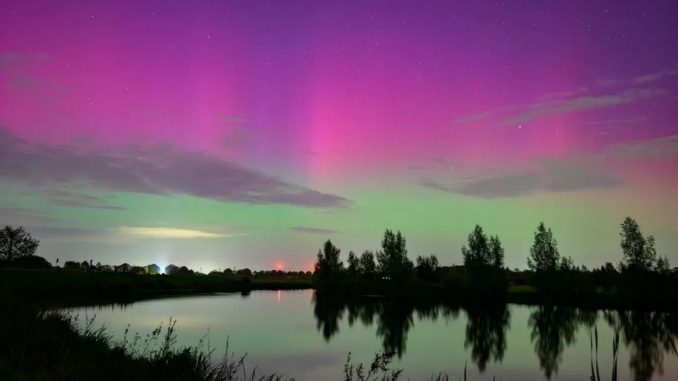
Northern Lights Forecast: Geomagnetic Storm Cause Aurora Borealis To Be Visible In These States Tonight
A swath of states in the northern U.S. could get another chance to see the northern lights Friday night, according to a National Oceanic and Atmospheric Administration forecast, after a geomagnetic storm brought the aurora borealis farther south.
KEY FACTS
NOAA forecast a KP index of five for Friday night, meaning the aurora borealis will become brighter and there is a chance the lights may be more active.

The event will allow the aurora borealis to be “quite pleasing to look at” for anyone north of the viewing line, NOAA said.
The viewing line is forecast to reach as low as the northern edge of Iowa, though NOAA suggests people be as far north of the line as possible to have a better chance at seeing the northern lights.
Earlier this week, NOAA issued a severe geomagnetic storm watch, an event the agency said could impact critical infrastructure like power grids, GPS and radio disruption, while also causing aurora borealis to appear as far south as Alabama on Thursday.
WHERE WILL THE NORTHERN LIGHTS BE VISIBLE?
It is predicted that some parts of the northern United States—Alaska and the northern regions of Washington, Idaho, Montana, North Dakota, Minnesota, and Wisconsin—will have a better chance of seeing the aurora. There is less chance of viewing the northern lights in a few other states, such as South Dakota, Montana, Iowa, Wisconsin, Michigan, New York, New Hampshire, Vermont, and Maine.
WHAT’S THE BEST WAY TO SEE THE NORTHERN LIGHTS?
NOAA encourages viewers to watch from a high vantage point, like a hill, while the optimal time to see the aurora borealis is between 10 p.m. and 2 a.m. in areas with little to no light pollution.
WHAT’S THE BEST WAY TO PHOTOGRAPH THE NORTHERN LIGHTS?
Smartphones can pick up the aurora even if the naked eye can’t see it. Visit Iceland, Iceland’s tourism website, advises turning on night mode to increase smartphone camera exposure.
KEY BACKGROUND
Solar Cycle 25—an 11-year cycle the sun began in 2019—has increased the likelihood of states being able to view the aurora borealis phenomenon. An increase in sunspots and geomagnetic storms—caused by a burst of energy and particles released by the sun—contribute to stronger aurora forecasts. The cycle is expected to peak between late 2024 and early 2026, according to NASA, meaning northern lights sightings will continue throughout next year. Though the peak has yet to happen, the sun’s activity has been busier than anticipated and there will likely be more geomagnetic storms leading up to 2026, scientists say.
Leave a Reply